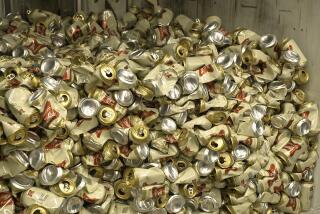Belgians Brew Up Some Suds in Different Styles
- Share via
BRUSSELS — In Belgium, a glass of beer can be enjoyed much as one might savor a Bordeaux in France.
Each brew, it seems--from the tawny Duvel to the rich earthiness of Chimay--offers its own special character. In cafes, the beers are served in wide-mouthed glasses, allowing drinkers to appreciate the liquid’s various “noses,” which are sometimes floral, sometimes hoppy and, in the case of the unusual framboise and kriek brews, redolent of raspberry and cherry.
For Belgians at least, their beers share a further trait in common with wine--they are often enjoyed as an accompaniment to contemplation and lofty discussion. Unlike the noise of English pubs or German beer halls, Belgian cafes are fairly quiet places.
“Our beers are what I call ‘meditative,’ ” says Jean Pierre Van Roy, owner of Cantillon, the last surviving brasserie in Brussels’ city center. “Brewing is an art like the making of wine, and to drink a beer is to meditate on the sun and other things.”
Belgium’s relatively small size (population of 9.9 million) and the limited production of its breweries have helped to keep Belgian beers very much a secret among those familiar with British ales and German lagers.
Nevertheless, the country is home to l00 active breweries, many of them centuries old, which produce over 400 separate beer labels. Some, like Stella Artois and Jupiler, are typical lagers, hardly distinguishable from Miller or Budweiser. The majority, however, are brands produced by the highly unusual Belgian brewing tradition, and their complexity of flavors and range of styles draw frequent comparisons to wine.
Major Belgian beer labels such as Duvel, Chimay, Orval and Corsendonk are available in specialty liquor stores in the United States. To guage their true variety, though, one must travel to Brussels, the Belgian capital, or such cities as Brugge and Ghent in Flanders.
In Brussels, a visitor could travel from cafe to cafe for a long while before having to repeat an order. Such cafe-hopping, however, must be approached with care. Belgian beers are frequently much stronger in alcohol content than American brews.
Duvel--the name means devil in Flemish--appears more like a typical beer than most Belgians with its tawny color and creamy head, but behind the disguise lies a heady 8.2% beer (American beers commonly contain half that alcohol strength). Belgium’s strongest is the 12% Bush beer.
While they are characteristically an unpatriotic lot--Belgians freely admit this and it is perhaps one reason why the European Community has chosen Brussels as its administrative capital and chief rendezvous point for its 12 member nations--the people are nevertheless quite proud of their beers and brewing traditions.
Those traditions can be traced to the country’s monasteries, where brewing was among the monks’ peaceful industries. Today, distinctive ales are still produced at five Belgian monastaries: Chimay, Orval, Rochefort, Westmalle and Westvleteren. So-called abbaye beers, such as Corsendonk, are brewed according to monks’ recipes but by licensed commercial brewers.
Chimay’s master brewer, Brother Theodore, is something of a living legend in Belgium. He has faithfully maintained the tradition of ale brewing, but has also been an innovator. He created Chimay’s Cinq Cents brew to commemorate the recent 500th anniversary of the principality of Chimay, in the southern Hainaut region, part of French-speaking Wallonia.
Indeed, only in Belgium is beer still brewed as it was in the Middle Ages before the discovery of yeasts. Such lambic beers are spontaneously fermented by atmospheric yeasts and other microflora. A straight lambic has little carbonation and, for beer, an unexpected sourness.
Fruit flavors are often added, resulting in the raspberry-flavored framboise and cherry-flavored kriek beers. Less common are cassis and peach-flavored lambics . Gueuze beers are a blend of young and old lambic beers, which results in a sweeter beer. The difference is not unlike that of a single malt whiskey and a blend.
In Brussels, where dozens of breweries once flourished as they did in cities across Belgium, the last suviving traditional brasserie is the century-old Cantillon at 56 Rue Gheude. Owner and master brewer Jean Pierre Van Roy has opened a Gueuze Museum (Musee Bruxellos de la Gueuze), and groups and individuals may tour the brewing operation from mid-October to the end of April, every Saturday from l0 a.m. to 5 p.m. or during the week by appointment.
“The museum is a way to preserve and promote artisanal lambic beers and to protect their quality and reputation,” Van Roy said. “It is very much a living museum.”
In a rooftop fermenting room, an enormous vat lies open. The tiles of the roof are arranged so that air can pass through, admitting the atmospheric yeasts. According to Van Roy, slight differences in atmospheric composition yield different tastes in the resulting lambics and gueuzes . The warm winters of recent years, for example, have had a softening effect on the beers.
The Cantillon brewery, a family operation whose staff includes Van Roy’s wife and son, produces limited quantities of lambics , gueuze and framboise beers. All are aged for some amount of time, the lambics for up to three years. The beers are bottled in what look like wine bottles, and are even corked like wine. A tour ends with a tasting session.
In Brugge, a visitor will find the intricacies of Belgian beers explained in seminars conducted for groups regularly at the Beer Academy (Kemelstraat 5). Pub owner Jan De Bruyne covers not only the various kinds of Belgian beers, but also what foods are best served with them. In the main room of the pub, De Bruyne offers more than 300 Belgian beers for sale. Many of these are aged up to seven years.
Clearly, a Budweiser would never last that long, but Belgian beers--such as the rich and slightly sour Rodenbach, called the “Burgundy of Belgium” for its red color, attain unusual, port-like complexities in the aging process.
At the beginning of this century, 31 breweries made their home in Brugge. Today, only two are still operating.
De Gouden Boom (The Golden Tree) opened in 1872 and is now managed by Paul Vanneste, a fourth-generation brewer. On a tour of De Gouden Boom, the thin Lincolnesque figure of Vanneste, who stands over 6 feet 6 inches tall, bends to pass under pipes carrying Brugs tarwebier (in French, “Blanche de Bruges,” a wheat or “white” beer, another Belgian specialty brew known for its slightly tart, fruity flavors).
Along with Brugs tarwebier, De Goudon Boom also brews a strong abbaye ale and a thick, creamy Brugse Tripel, which packs a 9.5% alcoholic punch. Close by the brewery on Langestraat, ‘t Paardje Restaurant (The Little Horse) serves steaming buckets of mussels cooked in Brugs tarwebier --an almost irresistible combination best washed down with draft Brugs tarweiber .
Unlike the French, who defend their country’s wines almost as staunchly as they would their own homes, the Belgians appear a bit lackadaisical when it comes to promoting their brewing heritage.
Thus, as 1992 and the creation of a European super-market approaches, there is some concern that only the very biggest breweries in Belgium will withstand the competitive onslaught that can be expected from English, German and Dutch companies.
Small, artisanal brewers like Cantillon’s Van Roy and De Gouden Boom’s Vanneste fear that they may be swallowed up in the process.
“I am anxious that the big breweries will take over the smaller ones,” Vanneste says. “If that happens, the tradition we have preserved here may be lost.”
For general information on travel to Belgium, contact the Belgian National Tourist Office, 745 Fifth Ave., Suite 714, New York 10151, (212) 758-8130.
More to Read
Sign up for The Wild
We’ll help you find the best places to hike, bike and run, as well as the perfect silent spots for meditation and yoga.
You may occasionally receive promotional content from the Los Angeles Times.






